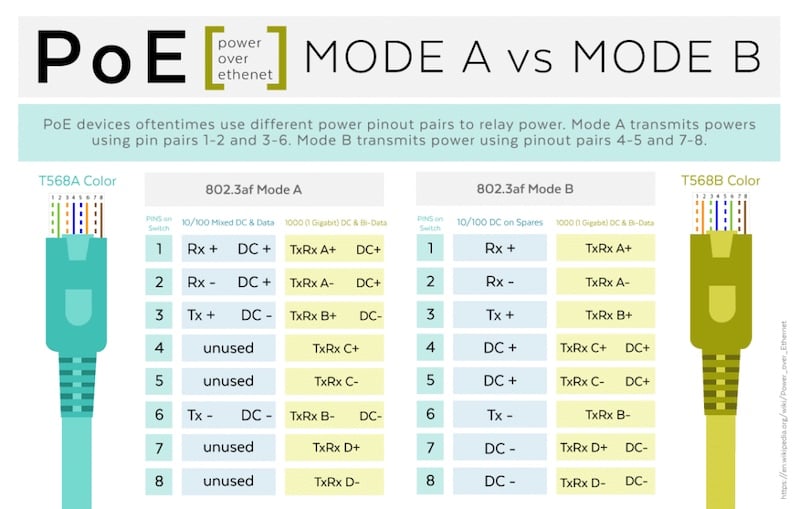Choosing a PoE Standard for Designs: PoE, PoE+, and PoE++
Power over Ethernet standards come with important distinctions for designers to consider when unifying power and connectivity.
In an age where more designs require internet connectivity, designers can save space by leveraging dual-purpose standards like Power over Ethernet. This standard (and others like it) minimize the number of ports required to operate a device. Instead of requiring multiple ports to supply power, communications, and debugging capabilities, a single port can be used to simply design and qualifications processes while maintaining a small size.

PoE leverages two or four twisted pairs in Ethernet cables to transfer power without impacting communication capacity. Image used courtesy of FS
While Ethernet is not the only method of connecting to a local network, it provides a physical wired connection instead of a wireless one requiring a router to operate. As such, for systems needing a near 100% up-time, Ethernet may be the most reliable method. Instead of requiring both a power and Ethernet port, certain designs can leverage the well-developed Power over Ethernet standard (PoE).
There are now three generations of the PoE standard, each offering designers distinct advantages. This article covers the distinguishing features of these PoE standards to give designers the knowledge they need to unite power and communications in their own devices.
PoE Puts Comms and Power in One Port
Inside a PoE cable are four twisted pairs, eight in total. Both PoE (IEEE 802.3af) and PoE+ (802.3at) use two pairs to transmit data and two to transmit power. PoE++ (IEEE 802.3bt) taps into all four twisted pairs for both data and power, allowing them to transmit power at higher wattages.
The first generation of the PoE standard, aptly named PoE, can supply up to 12.95 W to devices with voltages ranging from 37–57 V. At the time of its release (2013), this standard gave designers some headroom for low-powered designs but was quickly upgraded to the PoE+ standard to provide more power.

Inside a PoE cable. Image used courtesy of Nelly's Security
The PoE+ standard supplies up to 25.5 W to devices at voltages from 42.5–57 V.
The most recent version of the PoE standard, named PoE++, offers a major increase in power consumption, allowing designers to use up to 71 W for connected devices at the same voltage levels. Engineers can incorporate PoE in even more power-hungry designs, providing more versatility for Ethernet systems.

PoE makes use of the differential nature of Ethernet cables to allow power and communication signals to coexist, providing a power source without impacting communications bandwidth. Image used courtesy of Versa Technology
It’s also worth mentioning that PoE doesn’t impact transmission speeds (in theory, at least). Since Ethernet uses differential pairs for data transmission, it’s possible to increase the common-mode voltage of a twisted pair with little effect on the communications ability.
Choosing a PoE Standard
When choosing which PoE standard to include as part of a design, the differences between the standards make the choice a simple one: select the standard that provides sufficient power to the device. If, for example, low power consumption is expected, PoE will be sufficient, whereas higher power designs may need to leverage PoE+ or PoE++.

By leveraging more twisted pairs, PoE standards have evolved to give designers more power capacity and PoE support in high-power devices. Image used courtesy of Versitron
This is certainly not the only factor to consider when selecting a standard; communication bandwidth can also dictate the IEEE standard (and, therefore, PoE standard) that should be used. If, however, power availability is the only consideration, the simple evolution of the PoE standard makes selection highly intuitive.
Simplifying Connected Designs
While PoE may not be a one-size-fits-all solution, for use cases that require high-quality or noiseless power sources, PoE is a useful option to provide streamlined connections. PoE simplifies the setup process and subsequent operation by using only a single port for connectivity and power.
As the number of connected devices continues to grow, the PoE standards may continue to evolve to keep up with demand. It is likely, however, that balancing reliable wired connections with wireless connections for less-critical devices can provide an optimal tradeoff for the future of networking technologies.








In my opinion PoE has one limitation when used for lighting and that is Phantom Load….components need to be powered in order to communicate. Seems silly to keep a smart switch powered just to communicate with a light to turn it on. So I’ve opted NOT to use PoE for lighting. Instead I’m just using 48Vdc; switching it on/off; using passive 0-10V dimming. PoE for security camera IS a good solution mostly because it is always on.